Temporal and Spatial Evolution of Meteorological Drought in Inner Mongolia Inland River Basin and Its Driving Factors
Abstract
1. Introduction
2. Materials and Methods
2.1. Overview of the Study Area
2.2. Data Source
2.3. Standardized Precipitation Evapotranspiration Index
2.4. Modified Mann-Kendall Test
2.5. Drought Three-Dimensional Identification Method
2.5.1. Drought Patch Identification
2.5.2. Drought Patch Time-History Connection
2.5.3. Extraction of Drought Event Characteristic Variables
- (1)
- drought duration is the number of months between the start time of the drought and the end time of the drought;
- (2)
- drought area is the maximum area covered by a drought event;
- (3)
- drought severity is the absolute value of the cumulative SPEI value during the drought event;
- (4)
- drought center is the weighted center of the gravity of the SPEI values in 3D space;
- (5)
- drought migration drought is the line of the center of mass of a month-by-month drought.
2.6. Cross Wavelet Transform
3. Results
3.1. Characteristics of the Temporal Evolution of Meteorological Drought
3.2. Spatiotemporal Analysis of Monthly, Seasonal and Annual Meteorological Drought Trends
3.2.1. Time Characteristics of Meteorological Drought Change Trend
3.2.2. Spatial Characteristics of Meteorological Drought Change Trend
3.2.3. Characterization of Changes in Seasonal Drought Intensity and Area Proportion
3.3. Spatial Distribution Characteristics of Meteorological Drought Intensity and Frequency
3.3.1. Spatial Variation Characteristics of Meteorological Drought Intensity
3.3.2. Spatial Variation Characteristics of Meteorological Drought Frequency
3.4. Evolutionary Pattern of Meteorological Drought Based on Three-Dimensional Identification Method
3.4.1. Identification Results of Meteorological Drought Events
3.4.2. Spatiotemporal Dynamic Evolution of Typical Meteorological Drought Event
4. Discussion
4.1. Driving Factor Study
4.2. Advantage and Uncertainty
5. Conclusions
- (1)
- As the time scale of the SPEI increased, the number of meteorological drought occurrences decreased; however, drought duration and drought intensity increased.
- (2)
- The trend of aridification was most pronounced in the spring, with the greatest number of areas showing a significant downward trend, and the areas showing a significant downward trend in SPEI were concentrated in the western part of the IMIRB.
- (3)
- The area with a high value of meteorological drought intensity in summer is the largest, accounting for 68.29%, but the area of high-frequency drought intensity is the smallest. Winter with high-intensity drought had the smallest area but the largest percentage of high-frequency areas.
- (4)
- The meteorological drought event, which occurred from April 2017 to December 2017, was the most severe, with the drought area and drought intensity reaching their maximum in June 2017. The drought event experienced five main processes: occurrence—intensification—attenuation—re-intensification— extinction, and the migration path of the drought center was characterized by the transmission from central—southwest—northeast.
- (5)
- There were correlations between atmospheric circulation factors, sunspot, and meteorological drought in the Inner Mongolian inland river basin. ENSO had the greatest effect on drought.
Author Contributions
Funding
Institutional Review Board Statement
Informed Consent Statement
Data Availability Statement
Conflicts of Interest
References
- Myhre, G.; Alterskjær, K.; Stjern, C.W.; Hodnebrog, Ø.; Marelle, L.; Samset, B.H.; Sillmann, J.; Schaller, N.; Fischer, E.; Schulz, M.; et al. Frequency of extreme precipitation increases extensively with event rareness under global warming. Sci. Rep. 2019, 9, 16063. [Google Scholar] [CrossRef]
- Chiang, F.; Mazdiyasni, O.; AghaKouchak, A. Evidence of anthropogenic impacts on global drought frequency, duration, and intensity. Nat. Commun. 2021, 12, 2754. [Google Scholar] [CrossRef]
- Ault, T.R. On the essentials of drought in a changing climate. Science 2020, 368, 256–260. [Google Scholar] [CrossRef]
- Marvel, K.; Cook, B.I.; Bonfils, C.J.; Durack, P.J.; Smerdon, J.E.; Williams, A.P. Twentieth-century hydroclimate changes consistent with human influence. Nature 2019, 569, 59–65. [Google Scholar] [CrossRef]
- Li, J.; Xi, M.; Pan, Z.; Liu, Z.; He, Z.; Qin, F. Response of NDVI and SIF to Meteorological Drought in the Yellow River Basin from 2001 to 2020. Water 2022, 14, 2978. [Google Scholar] [CrossRef]
- Liu, X.; Pan, Y.; Zhu, X.; Yang, T.; Bai, J.; Sun, Z.J. Drought evolution and its impact on the crop yield in the North China Plain. J. Hydrol. 2018, 564, 984–996. [Google Scholar] [CrossRef]
- Guo, Y.; Huang, S.; Huang, Q.; Leng, G.; Fang, W.; Wang, L.; Wang, H. Propagation thresholds of meteorological drought for triggering hydrological drought at various levels. Sci. Total Environ. 2020, 712, 136502. [Google Scholar] [CrossRef] [PubMed]
- Kazemzadeh, M.; Malekian, A. Spatial characteristics and temporal trends of meteorological and hydrological droughts in northwestern Iran. Nat. Hazards 2016, 80, 191–210. [Google Scholar] [CrossRef]
- Mishra, A.K.; Singh, V.P. A review of drought concepts. J. Hydrol. 2010, 391, 202–216. [Google Scholar] [CrossRef]
- Wu, Z.; Mao, Y.; Li, X.; Lu, G.; Lin, Q.; Xu, H. Exploring spatiotemporal relationships among meteorological, agricultural, and hydrological droughts in Southwest China. Stoch. Environ. Res. Risk Assess. 2016, 30, 1033–1044. [Google Scholar] [CrossRef]
- McKee, T.B.; Doesken, N.J.; Kleist, J. The relationship of drought frequency and duration to time scales. In Proceedings of the 8th Conference on Applied Climatology, Anaheim, CA, USA, 17–22 January 1993; pp. 179–183. [Google Scholar]
- Palmer, W.C. Meteorological Drought; US Department of Commerce Weather Bureau: Taunton, MA, USA, 1965; Volume 30.
- Vicente-Serrano, S.M.; Beguería, S.; López-Moreno, J.I. A multiscalar drought index sensitive to global warming: The standardized precipitation evapotranspiration index. J. Clim. 2010, 23, 1696–1718. [Google Scholar] [CrossRef]
- Wambua, R.M.; Mutua, B.M.; Raude, J.M. Analysis of spatial and temporal drought variability in a tropical river basin using Palmer Drought Severity Index (PDSI). Int. J. Water Resour. Environ. Eng. 2017, 9, 178–190. [Google Scholar]
- Pandžić, K.; Likso, T.; Pejić, I.; Šarčević, H.; Pecina, M.; Šestak, I.; Tomšić, D.; Strelec Mahović, N. Application of the self-calibrated palmer drought severity index and standardized precipitation index for estimation of drought impact on maize grain yield in Pannonian part of Croatia. Nat. Hazards 2022, 113, 1237–1262. [Google Scholar] [CrossRef]
- Lorenzo, M.; Pereira, H.; Alvarez, I.; Dias, J. Standardized Precipitation Index (SPI) evolution over the Iberian Peninsula during the 21st century. Atmos. Res. 2023, 297, 107132. [Google Scholar] [CrossRef]
- Zhang, S.; Li, J.; Zhang, T.; Feng, P.; Liu, W. Response of vegetation to SPI and driving factors in Chinese mainland. Agric. Water Manag. 2024, 291, 108625. [Google Scholar] [CrossRef]
- Mupepi, O.; Matsa, M.M. A combination of vegetation condition index, standardized precipitation index and human observation in monitoring spatio-temporal dynamics of drought. A case of Zvishavane District in Zimbabwe. Environ. Dev. 2023, 45, 100802. [Google Scholar] [CrossRef]
- Guo, H.; Bao, A.; Liu, T.; Ndayisaba, F.; Jiang, L.; Kurban, A.; De Maeyer, P. Spatial and temporal characteristics of droughts in Central Asia during 1966–2015. Sci. Total Environ. 2018, 624, 1523–1538. [Google Scholar] [CrossRef]
- Shen, X.; Wu, X.; Xie, X.; Ma, Z.; Yang, M. Spatiotemporal analysis of drought characteristics in Song-Liao river basin in China. Adv. Meteorol. 2017, 2017, 1–13. [Google Scholar] [CrossRef]
- Zuo, D.; Cai, S.; Xu, Z.; Li, F.; Sun, W.; Yang, X.; Kan, G.; Liu, P.J.T.; Climatology, A. Spatiotemporal patterns of drought at various time scales in Shandong Province of Eastern China. Adv. Meteorol. 2018, 131, 271–284. [Google Scholar] [CrossRef]
- Tan, Y.X.; Ng, J.L.; Huang, Y.F. Spatiotemporal variability assessment and accuracy evaluation of standardized precipitation index and standardized precipitation evapotranspiration index in Malaysia. Earth Sci. Inform. 2023, 16, 67–89. [Google Scholar] [CrossRef]
- Kamruzzaman, M.; Almazroui, M.; Salam, M.; Mondol, M.A.H.; Rahman, M.M.; Deb, L.; Kundu, P.K.; Zaman, M.A.U.; Islam, A.R.M.T. Spatiotemporal drought analysis in Bangladesh using the standardized precipitation index (SPI) and standardized precipitation evapotranspiration index (SPEI). Sci. Rep. 2022, 12, 20694. [Google Scholar] [CrossRef] [PubMed]
- Qaisrani, Z.N.; Nuthammachot, N.; Techato, K.; Geosciences, A. Drought monitoring based on Standardized Precipitation Index and Standardized Precipitation Evapotranspiration Index in the arid zone of Balochistan province, Pakistan. Arab. J. Geosci. 2021, 14, 1–13. [Google Scholar] [CrossRef]
- Lotfirad, M.; Esmaeili-Gisavandani, H.; Adib, A. Drought monitoring and prediction using SPI, SPEI, and random forest model in various climates of Iran. J. Water Clim. Chang. 2022, 13, 383–406. [Google Scholar] [CrossRef]
- Ma, J.; Zhang, C.; Li, S.; Yang, C.; Chen, C.; Yun, W. Changes in Vegetation Resistance and Resilience under Different Drought Disturbances Based on NDVI and SPEI Time Series Data in Jilin Province, China. Remote Sens. 2023, 15, 3280. [Google Scholar] [CrossRef]
- Du, W.; Hao, Z.; Bai, M.; Zhang, L.; Zhang, C.; Wang, Z.; Xing, P. Spatiotemporal Variation in the Meteorological Drought Comprehensive Index in the Beijing–Tianjin–Hebei Region during 1961–2023. Water 2023, 15, 4230. [Google Scholar] [CrossRef]
- Ling, M.; Guo, X.; Shi, X.; Han, H. Temporal and spatial evolution of drought in Haihe River Basin from 1960 to 2020. Ecol. Indic. 2022, 138, 108809. [Google Scholar] [CrossRef]
- Wen, X.; Tu, Y.-H.; Tan, Q.-F.; Li, W.-Y.; Fang, G.-H.; Ding, Z.-Y.; Wang, Z.-N. Construction of 3D drought structures of meteorological drought events and their spatio-temporal evolution characteristics. J. Hydrol. 2020, 590, 125539. [Google Scholar] [CrossRef]
- Zhang, W.; Feng, K.; Wang, F.; Wang, W.; Zhang, Z.; Wang, Y.; Huang, S. Dynamic Evolution and Copula-Based Multivariable Frequency Analysis of Meteorological Drought Considering the Spatiotemporal Variability in Northwestern China. Water 2023, 15, 3861. [Google Scholar] [CrossRef]
- Xu, K.; Yang, D.; Yang, H.; Li, Z.; Qin, Y.; Shen, Y. Spatio-temporal variation of drought in China during 1961–2012: A climatic perspective. J. Hydrol. 2015, 526, 253–264. [Google Scholar] [CrossRef]
- Guo, H.; Bao, A.; Ndayisaba, F.; Liu, T.; Jiapaer, G.; El-Tantawi, A.M.; De Maeyer, P. Space-time characterization of drought events and their impacts on vegetation in Central Asia. J. Hydrol. 2018, 564, 1165–1178. [Google Scholar] [CrossRef]
- Feng, K.; Yan, Z.; Li, Y.; Wang, F.; Zhang, Z.; Su, X.; Wu, H.; Zhang, G.; Wang, Y. Spatio-temporal dynamic evaluation of agricultural drought based on a three-dimensional identification method in Northwest China. Agric. Water Manag. 2023, 284, 108325. [Google Scholar] [CrossRef]
- Guo, H.; Li, M.; Nzabarinda, V.; Bao, A.; Meng, X.; Zhu, L.; De Maeyer, P. Assessment of three long-term satellite-based precipitation estimates against ground observations for drought characterization in northwestern China. Remote Sens. 2022, 14, 828. [Google Scholar] [CrossRef]
- Xu, H.; Wang, X.; Zhang, X. Decreased vegetation growth in response to summer drought in Central Asia from 2000 to 2012. Int. J. Appl. Earth Obs. Geoinf. 2016, 52, 390–402. [Google Scholar] [CrossRef]
- Wang, Y.; Liu, G.; Guo, E. Spatial distribution and temporal variation of drought in Inner Mongolia during 1901–2014 using Standardized Precipitation Evapotranspiration Index. Sci. Total Environ. 2019, 654, 850–862. [Google Scholar] [CrossRef] [PubMed]
- Huang, J.; Xue, Y.; Sun, S.; Zhang, J. Spatial and temporal variability of drought during 1960–2012 in Inner Mongolia, north China. Quat. Int. 2015, 355, 134–144. [Google Scholar] [CrossRef]
- Forootan, E.; Khaki, M.; Schumacher, M.; Wulfmeyer, V.; Mehrnegar, N.; van Dijk, A.I.; Brocca, L.; Farzaneh, S.; Akinluyi, F.; Ramillien, G. Understanding the global hydrological droughts of 2003–2016 and their relationships with teleconnections. Sci. Total Environ. 2019, 650, 2587–2604. [Google Scholar] [CrossRef] [PubMed]
- Bo, M.; Guo, Y.-Q.; Tao, H.-B.; Liu, G.-Z.; Li, S.-K.; Pu, W. SPEIPM-based research on drought impact on maize yield in North China Plain. J. Integr. Agric. 2015, 14, 660–669. [Google Scholar]
- Merabti, A.; Darouich, H.; Paredes, P.; Meddi, M.; Pereira, L.S. Assessing Spatial Variability and Trends of Droughts in Eastern Algeria Using SPI, RDI, PDSI, and MedPDSI—A Novel Drought Index Using the FAO56 Evapotranspiration Method. Water 2023, 15, 626. [Google Scholar] [CrossRef]
- Ullah, I.; Ma, X.; Yin, J.; Omer, A.; Habtemicheal, B.A.; Saleem, F.; Iyakaremye, V.; Syed, S.; Arshad, M.; Liu, M. Spatiotemporal characteristics of meteorological drought variability and trends (1981–2020) over South Asia and the associated large-scale circulation patterns. Clim. Dyn. 2023, 60, 2261–2284. [Google Scholar] [CrossRef]
- Peng, Y.; Peng, T.; Li, Y. Spatiotemporal Characteristics of Drought in Northwest China Based on SPEI Analysis. Atmosphere 2023, 14, 1188. [Google Scholar] [CrossRef]
- Sheffield, J.; Andreadis, K.; Wood, E.F.; Lettenmaier, D.P. Global and continental drought in the second half of the twentieth century: Severity–area–duration analysis and temporal variability of large-scale events. J. Clim. 2009, 22, 1962–1981. [Google Scholar] [CrossRef]
- Wang, A.; Lettenmaier, D.P.; Sheffield, J. Soil moisture drought in China, 1950–2006. J. Clim. 2011, 24, 3257–3271. [Google Scholar] [CrossRef]
- Xie, Y.; Liu, S.; Fang, H.; Ding, M.; Liu, D. A study on the precipitation concentration in a Chinese region and its relationship with teleconnections indices. J. Hydrol. 2022, 612, 128203. [Google Scholar] [CrossRef]
- Su, L.; Miao, C.; Duan, Q.; Lei, X.; Li, H. Multiple-wavelet coherence of world’s large rivers with meteorological factors and ocean signals. J. Geophys. Res. Atmos. 2019, 124, 4932–4954. [Google Scholar] [CrossRef]
- Sun, B.; Wang, H.; Li, H.; Zhou, B.; Duan, M.; Li, H. A Long-Lasting Precipitation Deficit in South China During Autumn-Winter 2020/2021: Combined Effect of ENSO and Arctic Sea Ice. J. Geophys. Res. Atmos. 2022, 127, e2021JD035584. [Google Scholar] [CrossRef]
- Zhao, Q.; Liu, K.; Li, Z.; Liu, Y.; Yao, Y. A novel ENSO monitoring index and its potential for drought application. J. Atmos. Sol. Terr. Phys. 2021, 225, 105762. [Google Scholar] [CrossRef]
- Power, K.; Barnett, J.; Dickinson, T.; Axelsson, J. The role of El Niño in driving drought conditions over the last 2000 years in Thailand. Quaternary 2020, 3, 18. [Google Scholar] [CrossRef]
- Xing, Z.; Yu, Z.; Wei, J.; Zhang, X.; Ma, M.; Yi, P.; Ju, Q.; Wang, J.; Laux, P.; Kunstmann, H. Lagged influence of ENSO regimes on droughts over the Poyang Lake basin, China. Atmos. Res. 2022, 275, 106218. [Google Scholar] [CrossRef]
- Yang, P.; Zhai, X.; Huang, H.; Zhang, Y.; Zhu, Y.; Shi, X.; Zhou, L.; Fu, C. Association and driving factors of meteorological drought and agricultural drought in Ningxia, Northwest China. Atmos. Res. 2023, 289, 106753. [Google Scholar] [CrossRef]
- Wuyun, D.; Sun, L.; Chen, Z.; Hou, A.; Crusiol, L.G.T.; Yu, L.; Chen, R.; Sun, Z. The spatiotemporal change of cropland and its impact on vegetation dynamics in the farming-pastoral ecotone of northern China. Sci. Total Environ. 2022, 805, 150286. [Google Scholar] [CrossRef]
- Wei, B.; Wei, J.; Jia, X.; Ye, Z.; Yu, S.; Yin, S. Spatiotemporal Patterns of Land Surface Phenology from 2001 to 2021 in the Agricultural Pastoral Ecotone of Northern China. Sustainability 2023, 15, 5830. [Google Scholar] [CrossRef]
- Wan, L.; Bento, V.A.; Qu, Y.; Qiu, J.; Song, H.; Zhang, R.; Wu, X.; Xu, F.; Lu, J.; Wang, Q. Drought characteristics and dominant factors across China: Insights from high-resolution daily SPEI dataset between 1979 and 2018. Sci. Total Environ. 2023, 901, 166362. [Google Scholar] [CrossRef] [PubMed]
- Liu, S.; Kang, W.; Wang, T. Drought variability in Inner Mongolia of northern China during 1960–2013 based on standardized precipitation evapotranspiration index. Environ. Earth Sci. 2016, 75, 145. [Google Scholar] [CrossRef]
- An, Q.; He, H.; Nie, Q.; Cui, Y.; Gao, J.; Wei, C.; Xie, X.; You, J. Spatial and temporal variations of drought in Inner Mongolia, China. Water 2020, 12, 1715. [Google Scholar] [CrossRef]
- Lu, C.; Sun, Y.; Christidis, N.; Stott, P.A. Contribution of global warming and atmospheric circulation to the hottest spring in eastern China in 2018. Adv. Atmos. Sci. 2020, 37, 1285–1294. [Google Scholar] [CrossRef]
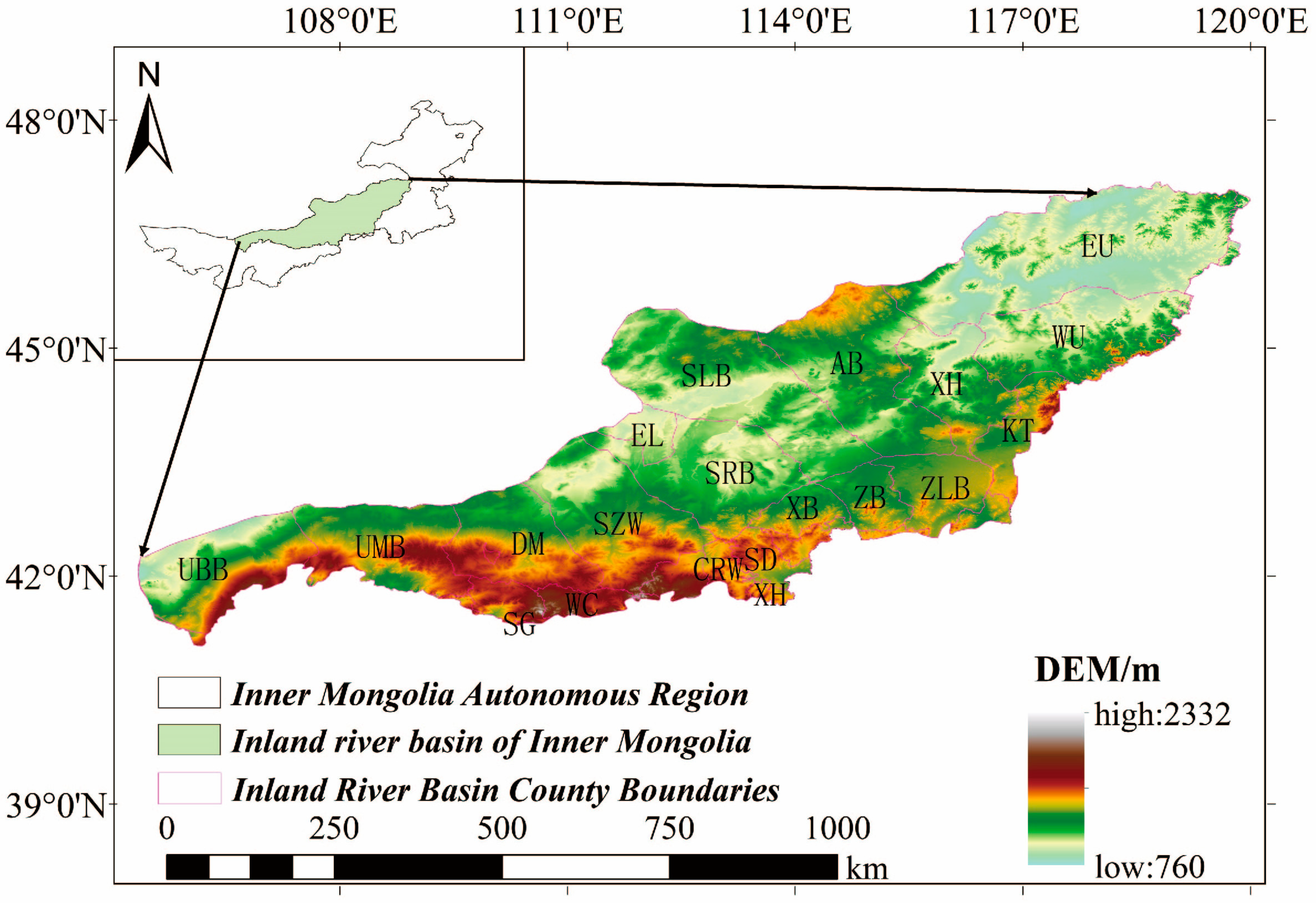

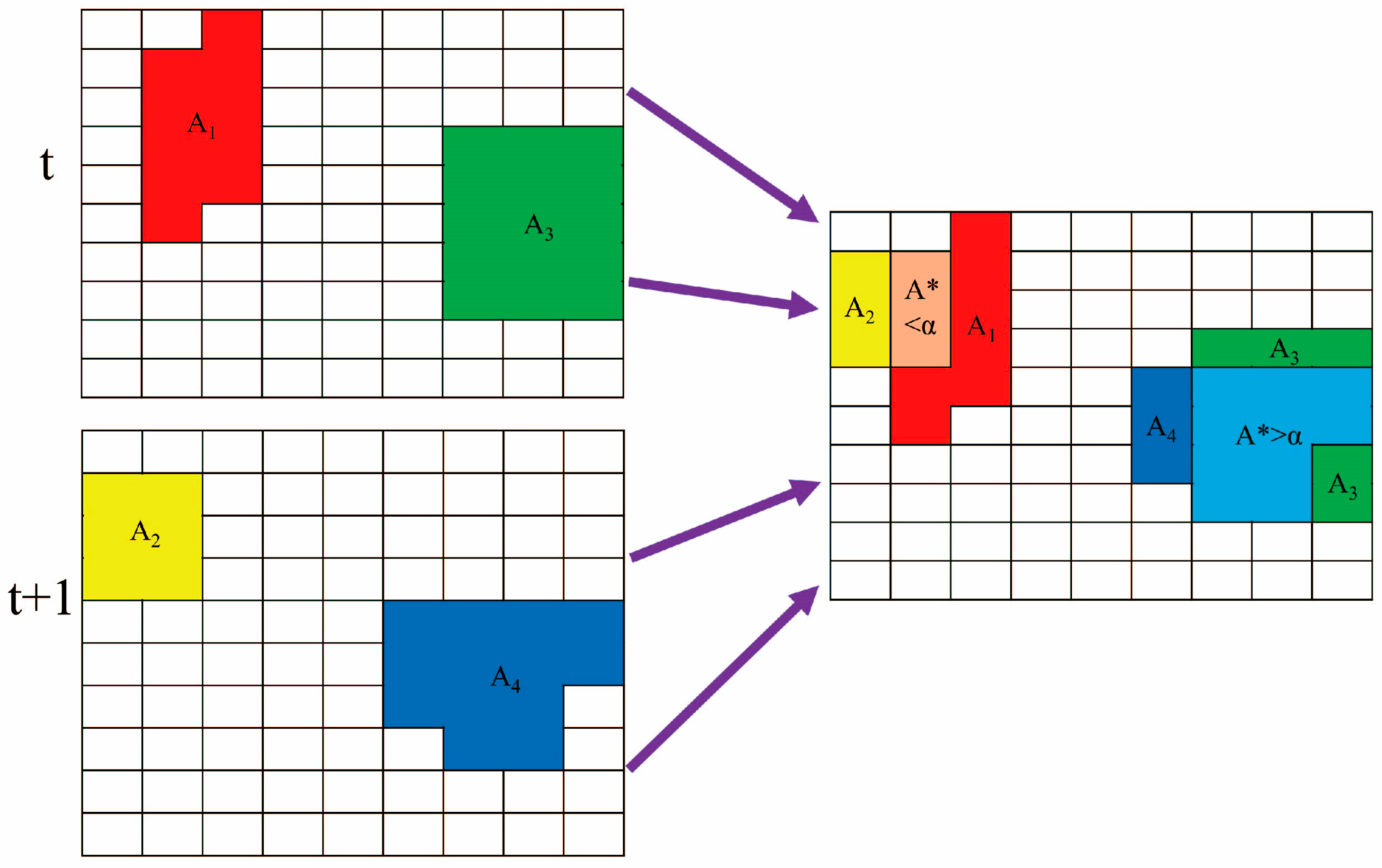



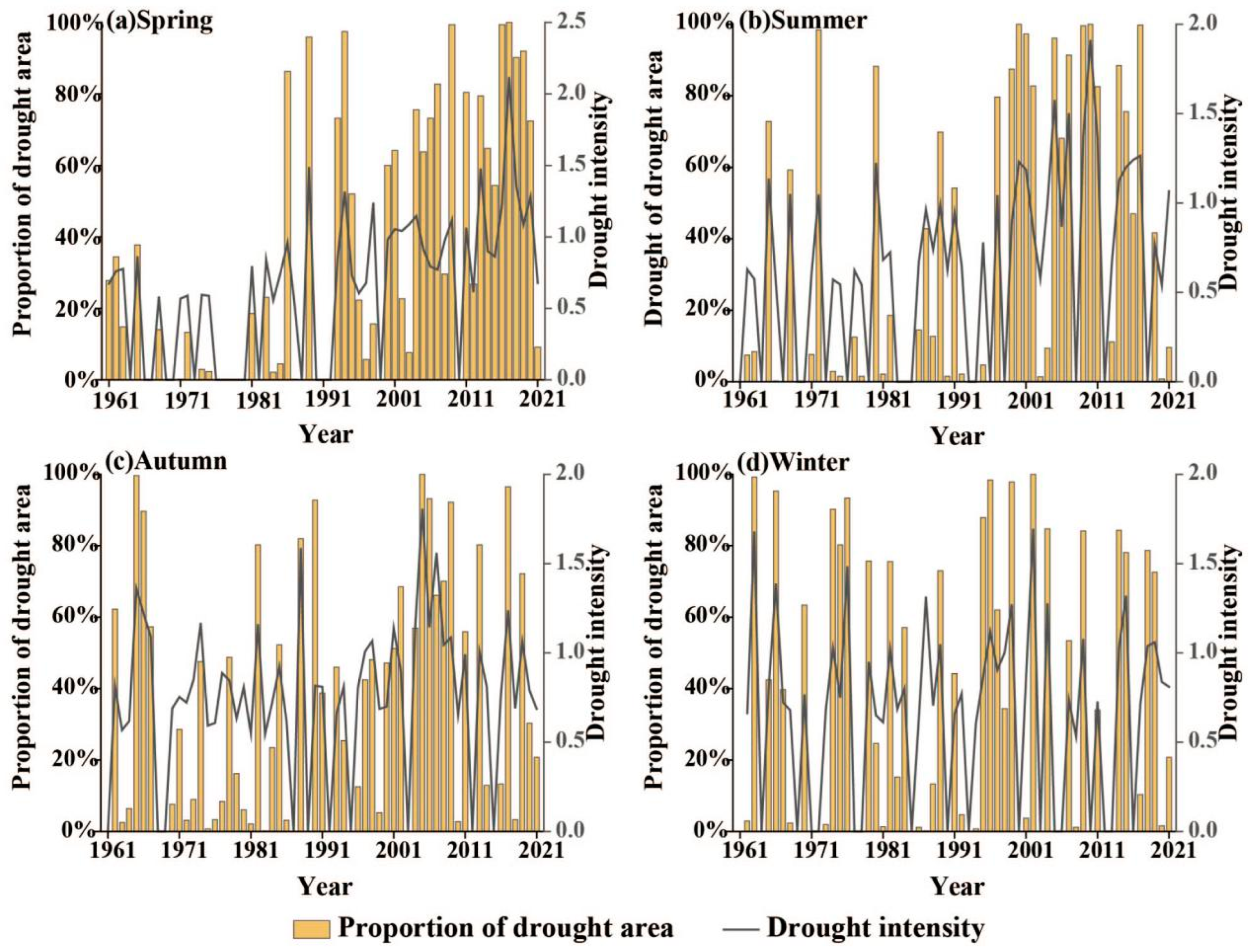

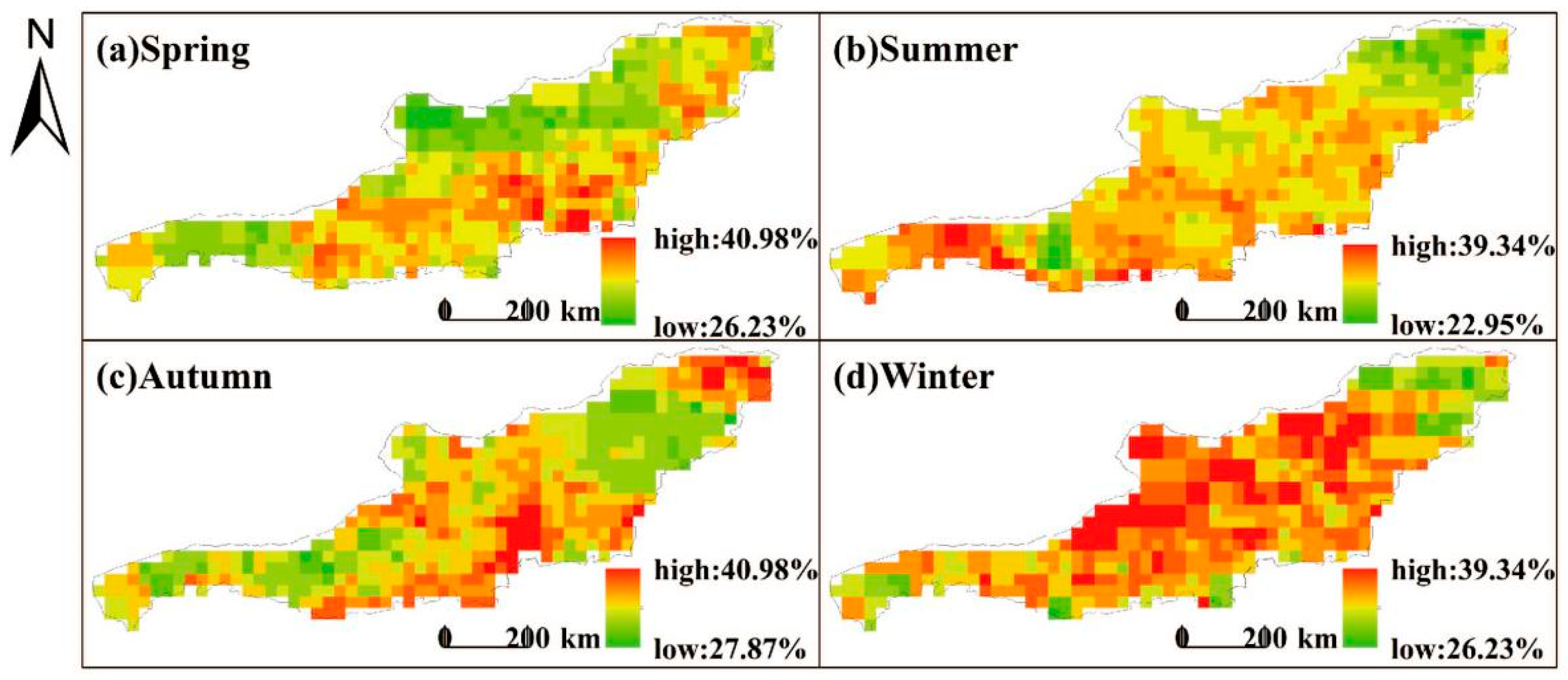
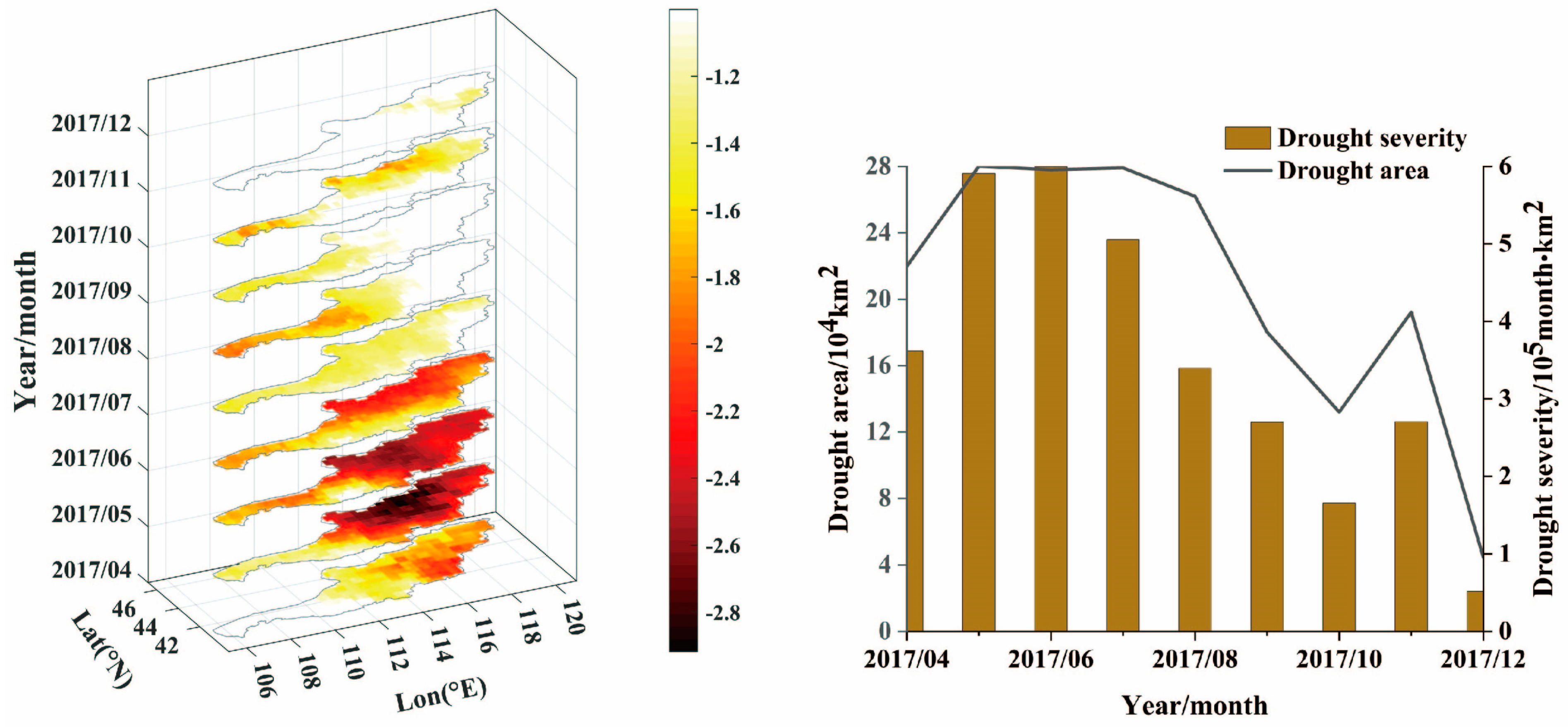


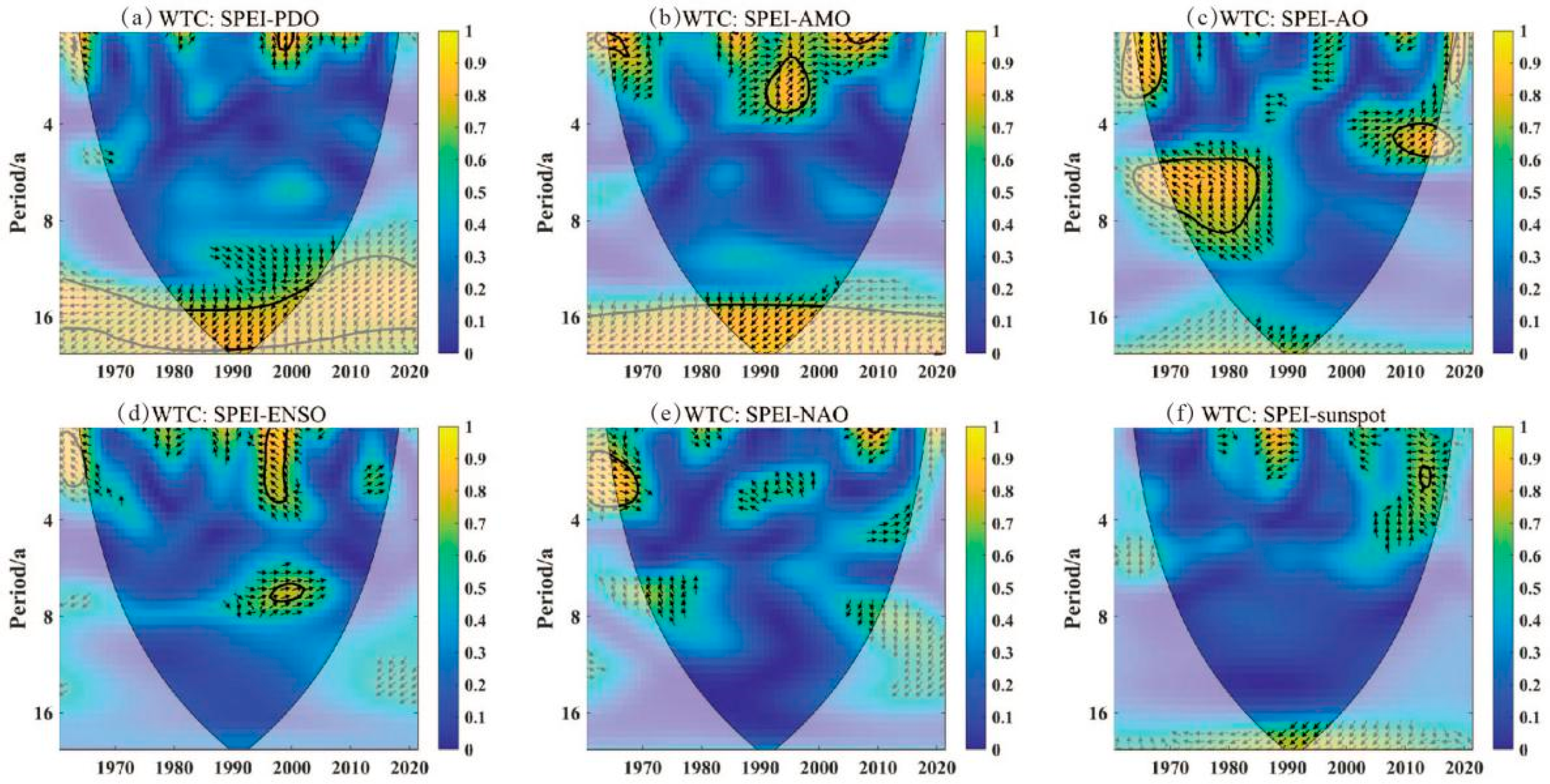
| Atmospheric Circulation Factors | Data Sources |
|---|---|
| PDO | http://www.ncdc.noaa.gov/teleconnections/pdo/ (accessed on 29 November 2023) |
| AMO | https://www.esrl.noaa.gov/psd/gcos_wgsp/Timeseries/ (accessed on 29 November 2023) |
| AO | https://www.ncdc.noaa.gov/teleconnections/ao/ (accessed on 29 November 2023) |
| ENSO | http://www.esrl.noaa.gov/psd/data/correlation/nina34.data (accessed on 29 November 2023) |
| NAO | https://www.ncdc.noaa.gov/teleconnections/nao/ (accessed on 29 November 2023) |
| sunspot | http://www.sidc.be/sunspot-data (accessed on 29 November 2023) |
| Drought Level | SPEI | Drought Severity |
|---|---|---|
| I | −0.5 < SPEI | No drought |
| II | −1 < SPEI ≤ −0.5 | Light drought |
| III | −1.5 < SPEI ≤ −1 | Moderate drought |
| IV | −2 < SPEI ≤ −1.5 | Severe drought |
| VI | SPEI ≤ −2 | Extreme drought |
| Number | Start Time (Year/Month) | End Time (Year/Month) | Drought Duration (Month) | Drought Center | Drought Area (104 km2) | Drought Severity (105 Months·km2) | |
|---|---|---|---|---|---|---|---|
| lon | lat | ||||||
| 96 | 2017/04 | 2017/12 | 9 | 113.67 | 43.25 | 2.802 | 3.299 |
| 73 | 2005/05 | 2006/01 | 9 | 113.30 | 43.02 | 2.774 | 3.001 |
| 42 | 1988/11 | 1989/09 | 11 | 114.67 | 43.36 | 2.728 | 2.731 |
| 67 | 2001/05 | 2002/03 | 11 | 106.93 | 41.29 | 2.729 | 2.370 |
| 77 | 2007/06 | 2007/11 | 6 | 114.89 | 43.61 | 2.728 | 2.130 |
| 86 | 2011/03 | 2011/11 | 9 | 113.22 | 42.81 | 2.802 | 2.081 |
| 89 | 2013/11 | 2014/05 | 7 | 113.12 | 42.99 | 2.678 | 1.927 |
| 98 | 2018/12 | 2019/05 | 6 | 114.87 | 43.74 | 2.734 | 1.714 |
| 5 | 1965/06 | 1965/12 | 7 | 113.32 | 42.92 | 2.597 | 1.679 |
| 66 | 2000/04 | 2000/09 | 6 | 113.79 | 43.35 | 2.442 | 1.602 |
Disclaimer/Publisher’s Note: The statements, opinions and data contained in all publications are solely those of the individual author(s) and contributor(s) and not of MDPI and/or the editor(s). MDPI and/or the editor(s) disclaim responsibility for any injury to people or property resulting from any ideas, methods, instructions or products referred to in the content. |
© 2024 by the authors. Licensee MDPI, Basel, Switzerland. This article is an open access article distributed under the terms and conditions of the Creative Commons Attribution (CC BY) license (https://creativecommons.org/licenses/by/4.0/).
Share and Cite
Zhang, W.; Guo, H.; Wu, Y.; Zhang, Z.; Yin, H.; Feng, K.; Liu, J.; Fu, B. Temporal and Spatial Evolution of Meteorological Drought in Inner Mongolia Inland River Basin and Its Driving Factors. Sustainability 2024, 16, 2212. https://doi.org/10.3390/su16052212
Zhang W, Guo H, Wu Y, Zhang Z, Yin H, Feng K, Liu J, Fu B. Temporal and Spatial Evolution of Meteorological Drought in Inner Mongolia Inland River Basin and Its Driving Factors. Sustainability. 2024; 16(5):2212. https://doi.org/10.3390/su16052212
Chicago/Turabian StyleZhang, Weijie, Hengzhi Guo, Yingjie Wu, Zezhong Zhang, Hang Yin, Kai Feng, Jian Liu, and Bin Fu. 2024. "Temporal and Spatial Evolution of Meteorological Drought in Inner Mongolia Inland River Basin and Its Driving Factors" Sustainability 16, no. 5: 2212. https://doi.org/10.3390/su16052212
APA StyleZhang, W., Guo, H., Wu, Y., Zhang, Z., Yin, H., Feng, K., Liu, J., & Fu, B. (2024). Temporal and Spatial Evolution of Meteorological Drought in Inner Mongolia Inland River Basin and Its Driving Factors. Sustainability, 16(5), 2212. https://doi.org/10.3390/su16052212







